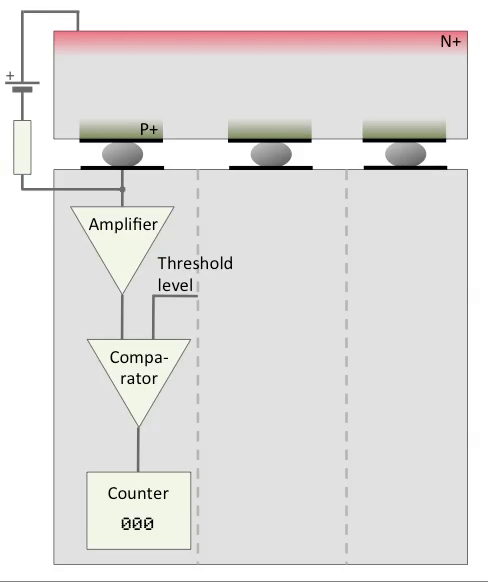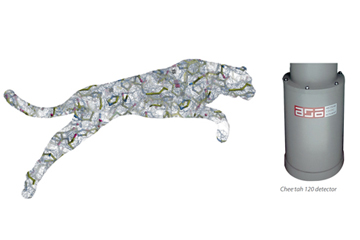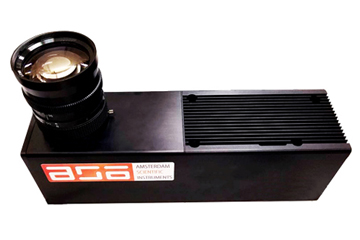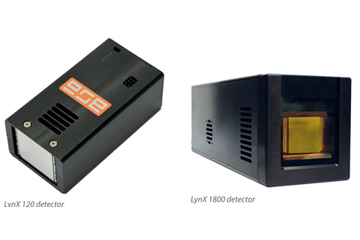Hybrid Pixel Detectors are a kind of ionizing radiation finder comprising of a variety of diodes. They are made to work in single-photon mode are known as Hybrid Photon Counting Detectors (HPCDs). These finders are intended to check the quantity of hits inside a specific time span. They have gotten a norm in most synchrotron light sources and X-beam location applications.
Hybrid Pixel Detectors are developed by holding a pixelated sensor (generally a variety of semiconductor diodes) to an application specific integrated circuit (ASIC). The ASIC gives fundamental charge-taking care of and readout hardware to each pixel of the sensor. The intensity of mixture pixels is that the ASIC rationale can be custom fitted to make identifiers streamlined for a specific application. The innovation is especially fit to synchrotron light sources, where the quantity of test procedures is colossal and the interest for specific locators is high.
Inside it the indicator part comprises basically of a micro strip identifier structure, each strip being partitioned into some number of short pieces, which establish the pixels. The sensor exhibit and the coordinating read-out chip are handled freely and are associated together just in the last advance. Thusly the material and procedures can be exclusively upgraded for the genuine reason for example identifier and gadgets. This methodology makes it conceivable to accomplish quick enough read-out and radiation hardness good with the LHC condition. The finder substrate is high resistivity silicon, albeit different materials than silicon, for example precious stone like diamond, are likewise thought of.
The advancement of hybrid pixel indicators for molecule identification with high spatial goal in high vitality material science tests has spun off various improvements with applications in imaging, most eminently biomedical imaging, and furthermore imaging in X-beam space science.
For the part of sensing element every pixel covers, actually, a little zone (10^(−4)cm2) over a slim (300μm) layer of silicon. It subsequently displays a low capacitance (0.2 - 0.4pF), which is commanded by the coupling to the neighbouring pixels instead of to the rear plane. The low capacitance is one of the key focal points of pixel identifiers since it permits quick sign moulding with extremely low clamour.
What is Hybrid Pixel Detectors?
Hybrid Pixel Detectors are ionizing radiation finder comprising of a variety of diodes dependent on semiconductor innovation and their related gadgets. The expression "mixture" originates from the way that the two principle components from which these gadgets are fabricated, the semiconductor sensor and the readout chip (otherwise called application-explicit incorporated circuit or ASIC), are produced autonomously and later electrically coupled by methods for a knock holding process. Ionizing particles are distinguished as they produce electron-opening sets through their connection with the sensor component, generally made of doped silicon or cadmium telluride. The readout ASIC is fragmented into pixels containing the fundamental gadgets to enhance and measure the electrical signs incited by the approaching particles in the sensor layer.
Hybrid Pixel Detectors Suppliers
We invest heavily in guaranteeing the best quality of our instruments. Correctly tried and made to bypass any blunder or mistake of repercussion while utilizing Hybrid Pixel Detectors. Our assembling offices are confirmed for world-class assembling and quality norms. We have cutting edge innovation upheld by enthusiastic building, quality ability and spotlight on precision and technology. Our thought process is to give the administration as well as an encounter as well, for this we helps our benefactors with simple access of specialized help and furthermore give exhibition of Hybrid Pixel Detectors if any client requests for it. Our after deal administrations are productive, for any enquiry or protest of the instrument, we guarantee to embrace all vital specialized help and substitution terms.
Hybrid Pixel Detectors Manufacturer
Overseen and tried by committed and experienced group of designers. We target giving the best nature of Hybrid Pixel Detectors than some other assembling units. Our production line is set up in tremendous zone with best quality and confirmed apparatus. Every unit of our item is tried with most excellent guidelines and precision guaranteeing pinpoint quality investigations. Our unit invests wholeheartedly in being the main unit of Hybrid Pixel Detectors Manufacturer of India.
We have faith in most extreme consumer loyalty accordingly; we guarantee to give the quality. Regardless of whether you discover any incorrectness in our item we will give investigate to amend the issue or complete substitution of detectors.
Types of Hybrid Pixel Detectors
Following are the subtypes of hybrid pixel detectors.
1. The lynx detector
One of the most widely and popular type of Hybrid pixel detector are The Lynx Detector series based on the Timepix/Medipix3/Timepix3 technology. It is suitable for a multitude range of applications because of its pixel pitch of about 55 µm.
It offers excellent performance and precise output with its capability to evaluate or discriminate x-ray energy in each of its 512×512 pixels. The detectors are made up of sensors of Si, GaAs and CdTe, which are divided into an array of pixels.
Each pixel is attached to a miniature bump-bonds with the readout ASIC's underneath the sensor. Our Lynx Detectors are manufactured with advanced machinery and precisely tested to avoid any inaccuracy.
Its key features are:
- It enables direct and single photon detection.
- In charge summing mode it increases point spread fucntion.
- It offers Zero noise, high S/N and high dynamic range.
- Short read out time and high frame rates.
- Modular detectors, enabling large active area.
- Increased high energy efficiency with high Z sensor materials.
2. TPX3 CAM
TPX3 is a type of hybrid pixel detector which is known to be world's first radiation imaging detector which operates in the mode of list. This device features fast optical camera for time stamping of optical photons i.e., each strike of radiation is recorded into a data of continuous stream. TPX3 cam device measures energy, time of strike, position of each detected quanta. The detector has a disposition of 256 x 256 spectrometers with CdTe or silicon sensors. The measured time stamp provides an additional possibility, review co-incident reviews or charge sharing between pixels. By its advanced approach a horizon for the ionizing radiation detection is unlocked. This device is used for range of applications such as particle tracking, Compton camera, energy resolved radiography (ions, neutrons, x-rays), Time-of-light imaging, etc.
The sensors can be adopted for imaging neutrons thorough deposition of converter layer. Following are its, key features:-
- Its wavelength is in range of 400 to 1000 nm.
- Its silicon sensors have increased light sensitivity.
- The time resolution is 1.6 ns and effective frame rate is below 500 MHz
- Lossless and data driven readout up to 80 Mhits / s.
- Flexible optical design outside the vacuum.
3. EM CHEETAH
ASI's Cheetah is a sub type of Hybrid pixel detector which is used for electron microscopic applications (biological and inorganic specimens).
Cheetah offers unprecedented possibilities for electron imaging, diffraction and tomography with its excellent sensitivity and speed. Scintillated detectors do not have the signal of noise ratio's which can be obtained using Cheetah.
Its lightning speed performance makes it ideal for dynamic processes and catching fast fading signals too.
It offers following features:
- Cheetah offers zero readout noise and high signals to noise.
- It features high dynamic range.
- Through thresholding it offers background noise suppression.
- High frame rates along minimum read out time.
- High-Z material offers increased high energy performance.





